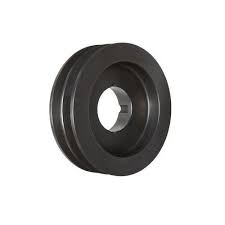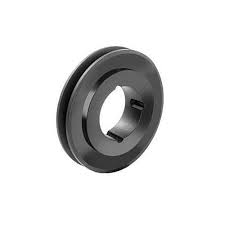Product Description
Timing pulley pricecast iron transmission machine parts manufacture best sale ace tensioner belt hob cutter SPA/06 european standard timing pulley
In power transmission, belts are flexible loops of material that can link 2 rotating shafts mechanically and transmit power between them. Belts are also the primary component in belt drives, where 1 or more continuous belts are fitted over 2 pulleys at 2 shafts and rotary motion is transferred from the driving pulley to the driven pulley.
As compared to chain drives and gear drives, belt drives run quietly and smoothly and do not need lubrication. Maintenance is also comparatively convenient, and the driven shaft speed can be easily altered by changing pulley sizes.
The most common types of belts are V-belts and timing belts. V-belts are the most common type of belt today, and as their name suggests, their cross-sectional shape comes in the form of a “V”. Generally endless, the “V” cross-sections of these belts lodge in the mating grooves of their corresponding V-belt pulleys, preventing slipping due to under-10sioning. In general, V-belts require less width and tension compared to flat belts.
Timing belts are toothed belts that enable positive drive. They have rows of interlocking teeth that fit securely with a toothed pulley to avoid slipping. Timing belts require less tension than other belts, have no slippage, and do not require lubrication, however their power capacity is lower than V-belts and chains. They are frequently used in camshafts of automobiles and crankshafts.
| Certification: | CE, ISO |
|---|---|
| Pulley Sizes: | V-Belt Pulley SPA/06 |
| Manufacturing Process: | Casting |
| Material: | Iron |
| Surface Treatment: | Phosphating |
| Application: | Chemical Industry, Grain Transport, Mining Transport, Power Plant |
| Samples: |
US$ 9999/Piece
1 Piece(Min.Order) | |
|---|

What safety considerations should be kept in mind when dealing with spa pulleys?
When dealing with spa pulleys, several safety considerations should be kept in mind to prevent accidents and ensure the well-being of individuals involved. Here’s a detailed explanation of the safety considerations:
1. Power Disconnection:
Before working on or near spa pulleys, ensure that the power to the spa equipment is completely disconnected. This prevents accidental starting of the motor or any unexpected movement of the pulleys. Turn off the power supply at the circuit breaker or switch and verify that there is no electrical power flowing to the spa system.
2. Lockout/Tagout Procedures:
When performing maintenance or repair tasks on the spa pulleys, follow proper lockout/tagout procedures. Lockout/tagout involves securing the power source with a lock or tag, preventing unauthorized re-energization of the equipment while work is being carried out. This helps to protect individuals from accidental activation of the spa system and ensures their safety during maintenance activities.
3. Personal Protective Equipment (PPE):
Wear appropriate personal protective equipment (PPE) when dealing with spa pulleys. This may include safety glasses or goggles to protect the eyes from debris or flying particles, gloves to provide hand protection, and any other necessary protective gear based on the specific task and potential hazards involved. PPE helps minimize the risk of injuries and enhances personal safety.
4. Proper Training and Knowledge:
Ensure that individuals working with spa pulleys have received proper training and possess the necessary knowledge and skills to perform the tasks safely. They should be familiar with the spa equipment, understand the potential hazards associated with pulley operations, and know the correct procedures for installation, maintenance, and repair. Proper training helps minimize the risk of accidents and ensures that work is carried out in a safe and competent manner.
5. Equipment Inspection:
Prior to any work involving spa pulleys, inspect the equipment for any signs of wear, damage, or malfunction. Ensure that the pulleys are in good condition, free from cracks, excessive wear, or any other issues that may compromise their integrity or performance. Address any identified problems before proceeding with the task to avoid potential accidents or failure during operation.
6. Proper Installation and Alignment:
During installation or replacement of spa pulleys, ensure that they are properly installed and aligned. Follow the manufacturer’s instructions and specifications for proper pulley installation, including the correct alignment, tensioning, and fastening procedures. Improper installation or misalignment can lead to premature wear, reduced performance, or unexpected pulley failures, which can pose safety hazards.
7. Regular Maintenance:
Incorporate regular maintenance of spa pulleys into the overall spa maintenance routine. This includes tasks such as cleaning, lubricating, and inspecting the pulleys for wear or damage. Regular maintenance helps identify and address any potential safety concerns, ensuring that the pulleys continue to function properly and safely.
8. Professional Assistance:
If you are unsure about any aspect of dealing with spa pulleys or if the task requires specialized knowledge or expertise, seek professional assistance. A spa technician or a qualified professional can provide guidance, perform the necessary maintenance or repair tasks, and ensure that safety protocols are followed.
In summary, when dealing with spa pulleys, it is important to prioritize safety. This includes disconnecting power, following lockout/tagout procedures, wearing appropriate PPE, receiving proper training, inspecting equipment, ensuring proper installation and alignment, conducting regular maintenance, and seeking professional assistance when needed. By adhering to these safety considerations, the risk of accidents or injuries associated with spa pulleys can be minimized, promoting a safe working environment for all individuals involved.

How are spa pulleys customized for specific spa makes and models?
Customizing spa pulleys for specific spa makes and models involves several considerations. Here’s a detailed explanation of the process:
1. Understanding Spa Requirements:
To customize spa pulleys, it is crucial to have a comprehensive understanding of the specific spa make and model. This includes knowledge of the motor specifications, pump requirements, and other driven components within the system. Understanding the power, speed, and torque requirements of the spa system helps in selecting or designing pulleys that will meet the precise needs of the spa.
2. Identifying Pulley Size and Ratio:
The size and ratio of the pulleys are key factors in customizing spa pulleys. By considering the motor speed and the desired speed of the driven component, the appropriate pulley sizes and ratios can be determined. Pulley size affects the rotational speed and torque output, while the ratio determines the speed relationship between the motor and the driven component. Careful calculations and analysis are performed to ensure the pulley dimensions and ratios align with the requirements of the specific spa make and model.
3. Pulley Material and Construction:
The choice of pulley material and construction is another aspect of customization. Different spa makes and models may have varying environmental conditions or operating parameters that require specific pulley materials. Factors such as temperature, moisture, and chemical exposure are considered when selecting materials that can withstand the spa environment. Additionally, the pulley’s construction, including its reinforcement and balancing features, may be tailored to enhance durability and performance based on the specific spa requirements.
4. Belt or Cable Compatibility:
Customizing spa pulleys also involves ensuring compatibility with the belts or cables used in the spa system. Pulleys must be designed to accommodate the specific belt or cable type, width, and thickness that are recommended by the spa manufacturer. The pulley’s design, such as groove shape, notch pattern, or tooth profile, should match the belt or cable to ensure proper engagement and grip. This compatibility ensures reliable power transmission and prevents slippage or premature wear.
5. Collaborative Design and Manufacturing:
In some cases, spa pulleys may be custom-designed and manufactured in collaboration with the spa manufacturer or a specialized pulley manufacturer. This collaborative approach allows for the development of pulleys that precisely meet the requirements of the specific spa make and model. The manufacturer’s expertise in pulley design, materials, and manufacturing processes ensures the production of high-quality pulleys tailored to the unique needs of the spa.
6. Quality Assurance and Testing:
Before integrating customized pulleys into the spa system, rigorous quality assurance and testing procedures are typically conducted. This ensures that the pulleys meet the required performance standards and operate safely within the spa environment. Testing may involve assessing factors such as power transmission efficiency, belt or cable engagement, and overall system functionality. Through these tests, any potential issues or improvements can be identified and addressed before finalizing the customized pulleys for the specific spa make and model.
By following these steps, spa pulleys can be customized to fit the specific requirements of different spa makes and models. This customization process ensures optimal performance, reliability, and compatibility, providing spa owners with pulleys that are specifically designed for their spa’s unique needs.

In which spa and hot tub applications are spa pulleys commonly used?
Spa pulleys are commonly used in various applications within spa and hot tub systems. Here’s a detailed explanation of the spa and hot tub applications where spa pulleys are commonly used:
1. Pump Systems:
One of the primary applications of spa pulleys is in pump systems. Spa and hot tub systems utilize pumps to circulate water, power jets, and maintain filtration. Spa pulleys are often used to connect the pump impeller to the motor or drive source. The pulley, when driven by the motor, transfers rotational power to the pump impeller, creating water movement and pressure.
2. Blower Systems:
In spa and hot tub systems, blowers are used to provide air for air jets, enhancing the hydrotherapy experience. Spa pulleys can be found in blower systems, connecting the blower motor to the blower fan. As the motor rotates, it drives the pulley, which in turn spins the blower fan, creating a flow of air into the air jets.
3. Control Systems:
Some spa and hot tub systems feature control panels or electronic systems that govern various functions, such as temperature control, lighting, or water feature activation. Spa pulleys may be used in these control systems to transfer rotational power from the motor or drive source to the components responsible for controlling these functions. This allows for the activation and adjustment of various features within the spa or hot tub.
4. Ozonators:
Ozonators are commonly used in spa and hot tub systems to generate ozone, which helps sanitize the water. Spa pulleys can be found in ozonator systems, connecting the ozonator motor to the ozone generator. The pulley transfers rotational power from the motor to the ozone generator, ensuring the ozone production process.
5. Waterfalls and Water Features:
Spa pulleys are also utilized in systems involving waterfalls or other water features in spas and hot tubs. They may be used to transfer rotational power from the motor to the components responsible for creating water flow, cascading effects, or other aesthetic features within the spa or hot tub.
6. Other Accessories:
Spa pulleys can be utilized in a range of other applications within spa and hot tub systems, depending on the specific design and configuration. These may include applications such as lighting systems, audio systems, or other accessories that require rotational power transfer from a motor or drive source.
It’s important to note that the specific use of spa pulleys in a spa or hot tub system may depend on the manufacturer, model, and design of the system. The documentation provided by the manufacturer or consulting with a professional in the spa and hot tub industry can provide accurate information on the specific applications where spa pulleys are commonly used in a particular system.


editor by CX
2023-10-20